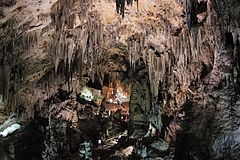Nerja caves
| Cuevas de Nerja | |

cave interior
|
|
| Location | Malaga |
|---|---|
| Coordinates | 36°45′42″N 3°50′45″W / 36.76167°N 3.84583°WCoordinates: 36°45′42″N 3°50′45″W / 36.76167°N 3.84583°W |
The Caves of Nerja (Spanish: Cueva de Nerja) are a series of caverns close to the town of Nerja in the Province of Málaga, Spain. Stretching for almost 5 kilometres (3.1 mi), the caverns are one of Spain's major tourist attractions. Concerts are regularly held in one of the chambers, which forms a natural amphitheatre.
The caves were re-discovered in modern times on 12 January 1959 by five friends, who entered through a narrow sinkhole known as "La Mina". This forms one of the two natural entrances to the cave system. A third entrance was created in 1960 to allow easy access for tourists. The cave is divided into two main parts known as Nerja I and Nerja II. Nerja I includes the Show Galleries which are open to the public, with relatively easy access via a flight of stairs and concreted pathways to allow tourists to move about in the cavern without difficulty. Nerja II, which is not open to the public, comprises the Upper Gallery discovered in 1960 and the New Gallery discovered in 1969.
In February 2012 it was announced that possibly Neanderthal cave paintings have been discovered in the Caves of Nerja.
Approximately 5 million years ago, during the Upper Miocene, water penetrated the fissures of the marble rock and dissolved it, forming a huge subterranean cavern. Seismic movement and landslides during the Holocene forced the water to find new pathways through the cave system and began the formation of the giant stalactites and stalagmites that can be seen in the cave.
Skeletal remains found in the caverns indicate that they were inhabited from about 25,000 BC up until the Bronze Age. Cave paintings from the Paleolithic and post-Paleolithic eras have been discovered on the walls of the cave. For about 4,000 years from 25,000 BC the caves were used seasonally by a small group of humans, and were occupied by cave hyena during the periods that the humans were absent. By 21,000 BC the human population had taken up year-round residence in the caves and had increased in number. A culture based on hunting in the local area had evolved, illustrated by first cave paintings found in the cave which date to around the time. Pine nuts and snails were also important elements of the diet. Up until around 10,800 BC the hunting culture continued to develop with more prey species being taken, including goats, rabbits, fish and marine mammals. A wide variety of animal bones, shells and fish bones from this time have been found in the cave, including the remains of a number of offshore species, along with stone and bone tools. By 4500 BC domesticated animals were being kept and the area around the cave was being used for farming and the production of pottery. By 3800 BC textiles and more advanced styles of pottery were being produced and parts of the cave were being used as a burial chamber.
...
Wikipedia

